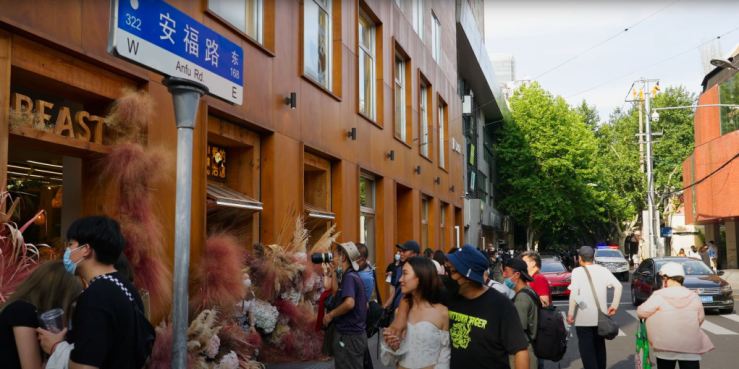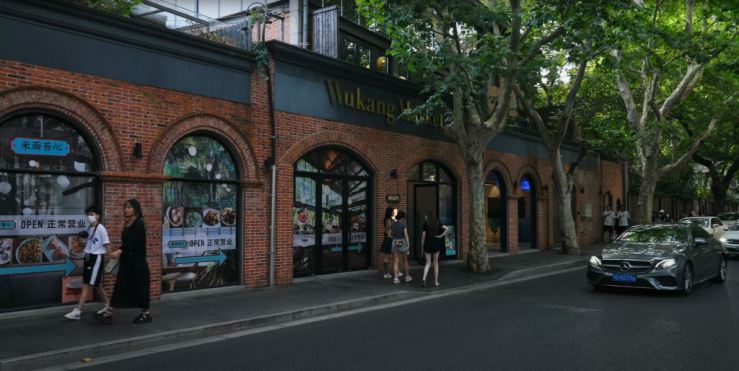It’s late August 2022 at 1645 in the Afternoon Beijing time during this month week of the Shanghai Walking through Shanghai in during the…. Walk through three main areas of central Shanghai…. From the shopping area of Anfu Road, popular among young tourists, to the area around South Shaanxi Road Station, and finally to the area around Jing’an Temple Station…. Anfu Road x Wukang Road 安福路 x 武康路, Wuyuan Road 五原路, Middle Huaihai Road 淮海中路, IAPM Mall 上海环贸iapm商场, South Shaanxi Road 陕西南路, Nanyang Road 南阳路, Area around Jing’an Temple Station 静安寺站周边地区……
Anfu Road安福路Anfu Lu is located in the northeast of Xuhui District, Shanghai. It starts from Changshu Road in the east and ends at Wukang Road in the west. It was built in 4-5 years of the Republic of China (1915-1916) and named Route Dupleix after the French admiral. In the 32nd year of the Republic of China, it changed its name to Jiangxi Anfu. Anfu Lu is located in the northeast of Xuhui District, Shanghai. It starts from Changshu Road in the east and ends at Wukang Road in the west. It is 862 meters long, 12.0 to 13.0 meters wide, and the roadway is 7.0 to 8.0 meters wide. Along the road are residences, art theatres and schools. On January 10, 2022, the Wukang Road-Anfu Road block in Xuhui District, Shanghai was selected as the first batch of national-level tourist resort……..
Wukang Road武康路Wukang Road is a road in Xuhui District , Shanghai . It is known as the “Celebrity Road” that “condenses Shanghai’s modern century history”. There are 14 outstanding historical buildings along the route, and 37 historical buildings are preserved. On June 11, 2011, Wukang Road, Xuhui District, Shanghai was selected as the third ” Famous Street of Chinese History and Culture ” approved by the Ministry of Culture and the State Administration of Cultural Heritage
Wukang Road was built in 1907. According to the Records of Geographical Names in Xuhui District , Shanghai : “The road was originally named Fu Kaisen Road, named after the American Fu Kaisen surname. In 1943, it was renamed Wukang Road and was named after the old county in Zhejiang Province.” [1-2]
In the late Qing Dynasty, Sheng Xuanhuai , a minister of the Westernization faction , was entrusted by Li Hongzhang to supervise the operation of Nanyang Public School (the predecessor of today’s Shanghai Jiaotong University). Equivalent to a 21st-century provost). After Fu Kaisen took office, in order to facilitate the travel of teachers and students, he built the road with his own salary. At first, there was no exact name. Later, because the French Concession was expanding its territory, it conflicted with the “Siming Office” of the Shanghai Ningbo Association. There were also conflicts with the United Kingdom, the United States, Russia and other countries. Fukaisen adjusted from it, and finally resolved to the satisfaction of all parties. In order to thank Fukaisen, the local people named the road Fukaisen Road. Since the professors hired by Fukaisen live in the urban area, it is much more convenient for teachers to go to work and school since the construction of this road. Therefore, it is highly praised by teachers and students. Wukang Road was originally a dirt road, with rice and vegetable gardens and farmhouses on sides, dense rivers and ponds, scattered with many graves. In 1914, Fukaisen Road was officially included in the French Concession, and Mintini, the first French consul in Shanghai, implemented the overall planning along Wukang Road in accordance with the most modern urban construction concept in the West at that time. This plan is gradually advancing to the surrounding area.
Wukang Road is 1,183 meters long and 12 to 16 meters wide. The whole road is curved and roughly runs north-south. From Huashan Road in the north, you can see Li Hongzhang ’s Lilac Garden, an important official in the late Qing Dynasty , and in the south, Huaihai Middle Road connects Tianping Road, Yuqing Road, and Soong Ching Ling’s former residence faces each other. On Wukang Road, where the phoenix trees are swirling, there are about 30 former residences of famous celebrities with a high “density”. The Spanish-style and French-Renaissance-style buildings along the route are very distinctive, making it one of the most European-style neighbourhoods in the central city of Shanghai.
Jing’an Temple Station 静安寺站周边地区…… Jing’an Temple, also known as Jing’an Ancient Temple, is located in Jing’an District , Shanghai. According to legend, its history can be traced back to the 10th year (247) of Sun Wu Chiwu of the Three Kingdoms. It was originally named Hudu Chongxuan Temple. In the first year of Xiangfu in the Song Dynasty (1008), it was renamed Jing’an Temple. In the ninth year of Jiading in the Southern Song Dynasty (1216), the temple moved from the Wusong River to the side of Lupu Feijingbang (now Nanjing West Road ), which was earlier than Shanghai. Jing’an Temple has a total construction area of 22,000 square meters. The entire temple forms a pattern of front temple and rear tower. It consists of three main buildings: Daxiong Hall , Tianwang Hall and Sansheng Hall . It is the oldest Buddhist temple in Shanghai. The temple houses the famous paintings of Bada Shanren and the cursive scroll of Wen Zhengming’s original work “Pipa Xing” . Jing’an District is also famous for its Jing’an Temple. The architectural style of Jing’an Temple is imitating the architectural style before the Ming Dynasty, and the typical representative is the shape of the bucket arch.
Jing’an Temple is the name of an interchange station between Lines 2, 7 and 14 of the Shanghai Metro. This station is located in Jing’an District, below the historic Jing’an Temple and the Jiu Guang shopping mall. It is part of the initial section of Line 2 that opened from Zhongshan Park to Longyang Road that opened on 20 September 1999; the interchange with line 7 opened on 5 December 2009 as part of that line’s initial section between Shanghai University and Huamu Road and the interchange with line 14 opened on 30 December 2021.
There are shuttle buses between Jing’an Temple and Hongqiao or Pudong airports. The shuttle bus from Pudong leaves the airport as ‘Airport Bus Line 2’ towards the ‘Airport City Terminal’ which is the official name of the Jingan Temple shuttle bus station and costs 22 ¥ as of January 2015. The ride takes about half an hour from Hongqiao Airport and 45–60 minutes depending on traffic from Pudong Airport. From Pudong the bus is usually faster and more convenient than the subway connection.
Rec Shanghai is about his walking, driving, riding running around views of China – People’s Republic of China sharing his immersive experiences in his video hope you could have a pure view about China today, sharing some 4K UHD videos to show pure China daily scenes for you I shoot in Shanghai and other locations in China. Let’s walk around China together… BEST VIEWED ON 2160px60 with the Volume turned on way up for immersiveness immersion…




